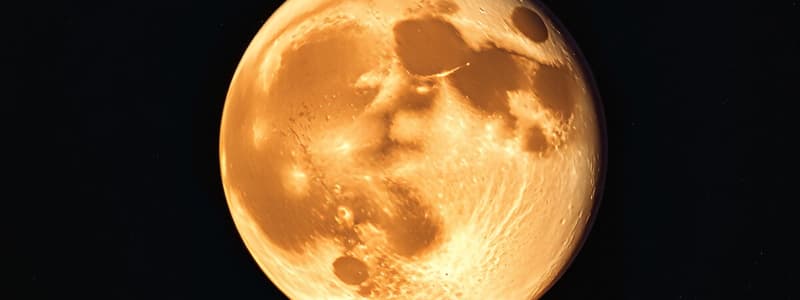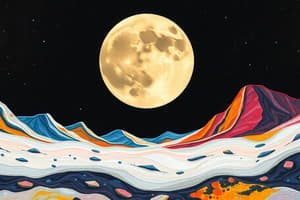Podcast
Questions and Answers
Temperatures on the Moon's surface are _____
Temperatures on the Moon's surface are _____
either very hot or very cold
What are the light-colored, mountainous regions of the Moon called?
What are the light-colored, mountainous regions of the Moon called?
highlands
What are the dark, smooth plains on the Moon called?
What are the dark, smooth plains on the Moon called?
maria
What are the features on the Moon formed by objects crashing into its surface called?
What are the features on the Moon formed by objects crashing into its surface called?
What is the material that falls back to the Moon's surface after an impact blast called?
What is the material that falls back to the Moon's surface after an impact blast called?
What are long trails of ejecta on the Moon's surface called?
What are long trails of ejecta on the Moon's surface called?
What are the valleylike features on the Moon's surface called?
What are the valleylike features on the Moon's surface called?
There is no erosion, other than surface creep and erosion due to impacts, on the Moon because there is no _____
There is no erosion, other than surface creep and erosion due to impacts, on the Moon because there is no _____
After a long period of impacts, the Moon's impact basins filled with what?
After a long period of impacts, the Moon's impact basins filled with what?
Scientists hypothesize that the Moon's crust is twice as thick where?
Scientists hypothesize that the Moon's crust is twice as thick where?
What are the layers of the Moon, from the surface inward?
What are the layers of the Moon, from the surface inward?
According to the most commonly accepted theory of the Moon's formation, the Moon is made from what?
According to the most commonly accepted theory of the Moon's formation, the Moon is made from what?
The most commonly accepted theory about the origin of the Moon explains why the Moon and Earth have what?
The most commonly accepted theory about the origin of the Moon explains why the Moon and Earth have what?
Why is the Moon invisible from Earth during a new moon?
Why is the Moon invisible from Earth during a new moon?
What is the closest point to Earth in the Moon's orbit called?
What is the closest point to Earth in the Moon's orbit called?
The inner portion of the shadow cast on Earth by the Moon is called?
The inner portion of the shadow cast on Earth by the Moon is called?
What is the blocking of the Sun's light by the Moon passing between Earth and the Sun called?
What is the blocking of the Sun's light by the Moon passing between Earth and the Sun called?
What is the farthest point from Earth in the Moon's orbit called?
What is the farthest point from Earth in the Moon's orbit called?
What is the state at which the Moon's orbital and rotational periods are equal called?
What is the state at which the Moon's orbital and rotational periods are equal called?
What occurs when the Moon passes through Earth's shadow?
What occurs when the Moon passes through Earth's shadow?
What is the length of time it takes for the Moon to go through a complete cycle of phases called?
What is the length of time it takes for the Moon to go through a complete cycle of phases called?
What describes the daily rise and fall of Earth's oceans caused by the gravitational pull of the Moon and Sun?
What describes the daily rise and fall of Earth's oceans caused by the gravitational pull of the Moon and Sun?
What is the outer portion of the shadow cast on Earth by the Moon called?
What is the outer portion of the shadow cast on Earth by the Moon called?
The fact that Earth observers always see the same side of the Moon is explained by the Moon's what?
The fact that Earth observers always see the same side of the Moon is explained by the Moon's what?
The tides on Earth are caused by the gravitational pull of the?
The tides on Earth are caused by the gravitational pull of the?
During an annular solar eclipse, the Moon what?
During an annular solar eclipse, the Moon what?
The Sun, Moon, and stars appear to rise in the east and set in the west because of the rotation of the Moon.
The Sun, Moon, and stars appear to rise in the east and set in the west because of the rotation of the Moon.
All societies base their calendars and timekeeping systems on the _____ of the Sun and Moon.
All societies base their calendars and timekeeping systems on the _____ of the Sun and Moon.
You can demonstrate that Earth rotates through the use of a Foucault Pendulum.
You can demonstrate that Earth rotates through the use of a Foucault Pendulum.
The period from one sunrise or sunset to the next is called the solar day.
The period from one sunrise or sunset to the next is called the solar day.
The length of time it takes for the Moon to go through a complete cycle of phases is called the lunar month.
The length of time it takes for the Moon to go through a complete cycle of phases is called the lunar month.
Annual variations in the length of the day and in temperatures are dependent on the _____ where you live.
Annual variations in the length of the day and in temperatures are dependent on the _____ where you live.
The plane of Earth's orbit around the Sun is called the _____
The plane of Earth's orbit around the Sun is called the _____
The seasons are caused by Earth's orbit around the Sun in combination with the tilt of Earth's axis.
The seasons are caused by Earth's orbit around the Sun in combination with the tilt of Earth's axis.
The hemisphere that is tilted toward the Sun experiences _____
The hemisphere that is tilted toward the Sun experiences _____
A _____ occurs when the Moon passes through Earth's shadow.
A _____ occurs when the Moon passes through Earth's shadow.
On the _____ solstice, the number of daylight hours for the northern hemisphere is at a maximum.
On the _____ solstice, the number of daylight hours for the northern hemisphere is at a maximum.
During the northern hemisphere's summer, the Sun appears lower in the sky than it does in winter.
During the northern hemisphere's summer, the Sun appears lower in the sky than it does in winter.
Study Notes
Moon Surface Characteristics
- Moon temperatures vary greatly, ranging from extremely hot to extremely cold.
- The light-colored mountainous regions on the Moon are known as highlands.
- Dark, smooth plains on the Moon are referred to as maria.
- Moon's surface features include impact craters resulting from collisions with objects.
Impact and Geological Features
- Ejecta is the material that falls back to the Moon's surface following an impact.
- Long trails of ejecta can be identified as rays.
- Valleylike formations on the surface are termed rilles.
- The Moon lacks significant erosion, except for surface creep and impact erosion, due to the absence of an atmosphere and flowing water.
Interior Composition & Formation Theories
- Following extensive impacts, the Moon's impact basins typically filled with lava.
- The Moon's crust is theorized to be thicker on its far side.
- The Moon consists of layers: crust, upper mantle, lower mantle, and core.
- Current formation theories suggest the Moon originated from debris from Earth and a colliding body, explaining the compositional similarities with Earth.
Lunar Mechanics & Phases
- During a new moon, the Moon is positioned between Earth and the Sun, rendering its illuminated side invisible from Earth.
- Perigee is the point in the Moon's orbit closest to Earth, while apogee is the farthest point.
- Synchronous rotation means the Moon's rotational period matches its orbital period, causing one side to always face Earth.
Eclipses and Their Definitions
- A solar eclipse occurs when the Moon obstructs sunlight from reaching Earth.
- A lunar eclipse takes place when the Moon moves into Earth's shadow.
- The inner shadow during an eclipse is the umbra, while the outer shadow is the penumbra.
Tides and Calendar Systems
- Tides on Earth are primarily influenced by the gravitational pull of the Moon.
- The lunar month refers to the duration for the Moon to complete a full cycle of phases and is key in calendars.
- Daily timekeeping and calendars in societies are based on the solar day, which is the time from one sunrise or sunset to the next.
Earth's Rotation and Seasonal Effects
- Earth rotates, which causes celestial bodies like the Sun and stars to appear to rise in the east and set in the west.
- Latitude affects annual variations in day length and temperature.
- Seasons result from Earth's orbit around the Sun coupled with the axial tilt, causing differing daylight hours.
- The hemisphere tilted toward the Sun experiences summer, while the opposite hemisphere experiences winter.
Studying That Suits You
Use AI to generate personalized quizzes and flashcards to suit your learning preferences.
Description
This quiz focuses on Chapter 27, which covers key concepts related to the Moon. It includes definitions of various features such as highlands, maria, and impact craters. Test your knowledge on the Moon's surface and its unique characteristics.




